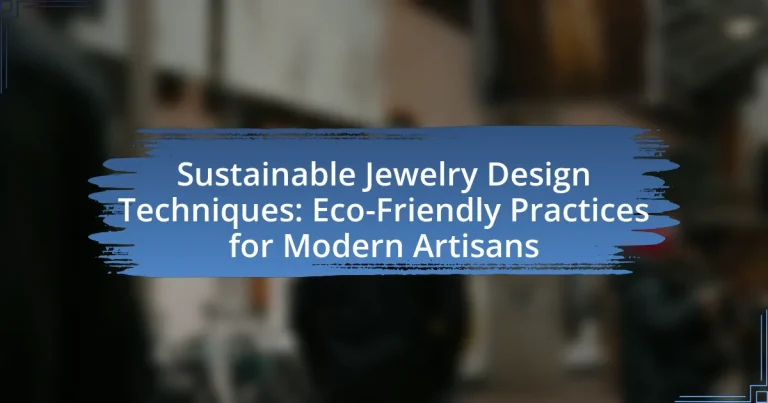Sustainable jewelry design techniques focus on eco-friendly practices that minimize environmental impact and promote social responsibility. Key methods include the use of recycled materials, ethical sourcing of gemstones, and environmentally friendly production processes. These practices not only reduce resource depletion and pollution but also foster a circular economy within the jewelry industry. The article explores various sustainable materials, the importance of ethical sourcing, and the challenges artisans face in implementing these practices, while also providing practical tips for enhancing sustainability in jewelry design.

What are Sustainable Jewelry Design Techniques?
Sustainable jewelry design techniques include the use of recycled materials, ethical sourcing of gemstones, and environmentally friendly production methods. Recycled materials, such as reclaimed metals, reduce the need for new mining, which can be harmful to ecosystems. Ethical sourcing ensures that gemstones are obtained from conflict-free zones, promoting social responsibility. Additionally, environmentally friendly production methods, such as using low-impact chemicals and energy-efficient processes, minimize the ecological footprint of jewelry creation. These practices are supported by industry standards and certifications, such as the Responsible Jewelry Council, which promotes sustainability in the jewelry sector.
How do these techniques contribute to eco-friendly practices?
Sustainable jewelry design techniques contribute to eco-friendly practices by minimizing environmental impact through responsible sourcing and production methods. Techniques such as using recycled materials reduce the demand for new raw materials, thereby conserving natural resources and decreasing waste. Additionally, employing ethical mining practices ensures that the extraction of materials does not harm ecosystems or communities. For instance, the use of lab-grown gemstones significantly lowers carbon footprints compared to traditional mining, which can produce substantial greenhouse gas emissions. These practices collectively promote sustainability in the jewelry industry by fostering a circular economy and reducing pollution.
What materials are considered sustainable in jewelry design?
Sustainable materials in jewelry design include recycled metals, ethically sourced gemstones, and organic materials such as wood and plant-based resins. Recycled metals, such as gold and silver, reduce the need for new mining, which can be environmentally damaging. Ethically sourced gemstones are obtained through practices that ensure fair labor and minimal environmental impact, often certified by organizations like the Responsible Jewelry Council. Organic materials, like sustainably harvested wood or biodegradable resins, offer alternatives that are renewable and have a lower ecological footprint. These materials collectively contribute to a more sustainable jewelry industry by minimizing resource depletion and promoting ethical practices.
How does sourcing impact the sustainability of jewelry?
Sourcing significantly impacts the sustainability of jewelry by determining the environmental and social implications of the materials used. Ethical sourcing practices, such as obtaining metals and gemstones from recycled or responsibly mined sources, reduce ecological damage and promote fair labor conditions. For instance, according to a report by the World Gold Council, responsibly sourced gold can minimize the carbon footprint associated with mining, which is often detrimental to ecosystems. Additionally, using recycled materials can decrease the demand for new mining operations, further conserving natural resources and reducing waste. Thus, the choice of sourcing directly influences the overall sustainability of jewelry production.
Why is sustainability important in the jewelry industry?
Sustainability is important in the jewelry industry because it addresses environmental and ethical concerns associated with mining and production processes. The extraction of precious metals and gemstones often leads to habitat destruction, pollution, and human rights violations, including labor exploitation. For instance, the World Gold Council reports that gold mining can produce up to 10 tons of waste for every ounce of gold extracted, highlighting the environmental impact. By adopting sustainable practices, such as sourcing recycled materials and ensuring fair labor conditions, the jewelry industry can reduce its ecological footprint and promote social responsibility. This shift not only meets consumer demand for ethical products but also fosters long-term viability for the industry.
What environmental issues are associated with traditional jewelry production?
Traditional jewelry production is associated with several environmental issues, primarily including resource depletion, pollution, and habitat destruction. The extraction of precious metals and gemstones often involves mining practices that lead to significant land degradation and loss of biodiversity. For instance, gold mining can result in the release of toxic chemicals like mercury and cyanide into local ecosystems, contaminating water sources and harming aquatic life. Additionally, the energy-intensive processes used in jewelry manufacturing contribute to greenhouse gas emissions, exacerbating climate change. According to a report by the World Gold Council, the mining and production of gold alone can generate up to 1.5 tons of waste for every ounce of gold extracted, highlighting the extensive environmental impact of traditional jewelry production.
How does sustainable jewelry design address these issues?
Sustainable jewelry design addresses environmental and ethical issues by utilizing eco-friendly materials and responsible sourcing practices. By opting for recycled metals, ethically sourced gemstones, and sustainable materials like lab-grown diamonds, designers minimize the ecological footprint associated with mining and production. For instance, the use of recycled gold can reduce energy consumption by up to 90% compared to newly mined gold, significantly lowering carbon emissions. Additionally, sustainable jewelry design often incorporates fair trade practices, ensuring that artisans receive fair wages and work in safe conditions, which directly combats exploitation in the jewelry supply chain. This holistic approach not only promotes environmental stewardship but also fosters social responsibility within the industry.
What are the key principles of sustainable jewelry design?
The key principles of sustainable jewelry design include the use of ethically sourced materials, environmentally friendly production processes, and a focus on longevity and recyclability. Ethically sourced materials ensure that gemstones and metals are obtained without exploiting workers or harming communities, as evidenced by the Fair Trade certification for gold and gemstones. Environmentally friendly production processes minimize waste and energy consumption, often utilizing techniques such as 3D printing and low-impact manufacturing methods. Additionally, designing for longevity and recyclability encourages consumers to cherish and eventually recycle their jewelry, reducing overall environmental impact. These principles collectively contribute to a more responsible and sustainable jewelry industry.
How can artisans incorporate these principles into their work?
Artisans can incorporate sustainable jewelry design principles into their work by utilizing eco-friendly materials, implementing ethical sourcing practices, and adopting energy-efficient production methods. For instance, artisans can choose recycled metals and ethically sourced gemstones to minimize environmental impact and support responsible mining practices. Additionally, they can reduce energy consumption by using solar-powered tools or adopting low-energy techniques in their production processes. These practices not only align with sustainability principles but also appeal to a growing market of environmentally conscious consumers, as evidenced by a 2021 survey indicating that 66% of global consumers are willing to pay more for sustainable brands.
What role does consumer awareness play in sustainable practices?
Consumer awareness plays a crucial role in promoting sustainable practices by influencing purchasing decisions and encouraging businesses to adopt eco-friendly methods. When consumers are informed about the environmental and social impacts of their choices, they are more likely to support brands that prioritize sustainability. For instance, a study by Nielsen found that 66% of global consumers are willing to pay more for sustainable brands, demonstrating that awareness directly drives demand for sustainable products. This demand compels companies to implement sustainable practices, such as using recycled materials and ethical sourcing, thereby fostering a market that values environmental responsibility.

What specific eco-friendly practices can modern artisans adopt?
Modern artisans can adopt several specific eco-friendly practices, including using recycled materials, sourcing ethically mined gemstones, and implementing sustainable production methods. By utilizing recycled metals, artisans reduce the demand for new mining, which can be environmentally damaging. Ethically sourced gemstones ensure that the extraction process respects both the environment and the rights of local communities. Additionally, sustainable production methods, such as minimizing waste and using non-toxic materials, further enhance the eco-friendliness of their work. These practices not only contribute to environmental conservation but also appeal to a growing market of environmentally conscious consumers.
How can artisans reduce waste in their jewelry-making process?
Artisans can reduce waste in their jewelry-making process by implementing techniques such as using recycled materials, optimizing design processes, and adopting efficient production methods. Utilizing recycled metals and gemstones minimizes the need for new raw materials, thereby decreasing environmental impact. Additionally, artisans can employ computer-aided design (CAD) software to create precise designs that reduce excess material during cutting and shaping. Research indicates that optimizing production techniques can lead to a reduction of up to 30% in material waste, as seen in studies conducted by the Jewelry Industry Council. By integrating these practices, artisans not only contribute to sustainability but also enhance the overall efficiency of their production processes.
What techniques can be used to recycle materials effectively?
Techniques to recycle materials effectively include mechanical recycling, chemical recycling, and upcycling. Mechanical recycling involves physically breaking down materials, such as metals and plastics, into smaller pieces for reuse, which is commonly used in the recycling of aluminum and glass. Chemical recycling, on the other hand, uses chemical processes to break down materials into their basic components, allowing for the creation of new products from previously unrecyclable plastics. Upcycling transforms waste materials into new products of higher quality or value, which is particularly relevant in sustainable jewelry design, where artisans can create unique pieces from discarded items. These techniques not only reduce waste but also conserve resources, as evidenced by the fact that recycling aluminum saves 95% of the energy required to produce new aluminum from raw materials.
How does minimalism influence sustainable jewelry design?
Minimalism influences sustainable jewelry design by promoting simplicity and functionality, which reduces material waste and encourages the use of eco-friendly resources. This design philosophy emphasizes clean lines and essential forms, leading artisans to create pieces that require fewer materials and energy in production. For instance, minimalist jewelry often utilizes recycled metals and ethically sourced gemstones, aligning with sustainable practices. Research indicates that minimalist designs can significantly lower the carbon footprint of jewelry production, as they prioritize quality over quantity and encourage consumers to invest in timeless pieces rather than fast fashion.
What are the benefits of using ethically sourced gemstones?
Using ethically sourced gemstones promotes environmental sustainability and social responsibility. Ethically sourced gemstones are obtained through practices that minimize ecological damage and support fair labor conditions. For instance, mining operations that adhere to ethical standards often implement measures to reduce habitat destruction and pollution, contributing to the preservation of biodiversity. Additionally, these gemstones are sourced from suppliers who ensure fair wages and safe working conditions for miners, thereby fostering community development and economic stability. According to a report by the Responsible Jewelry Council, ethical sourcing can lead to improved livelihoods for local communities and a reduction in human rights abuses associated with traditional mining practices.
How can artisans verify the ethical sourcing of their materials?
Artisans can verify the ethical sourcing of their materials by conducting thorough research on suppliers and utilizing certifications that indicate sustainable practices. This includes seeking suppliers who provide transparency in their supply chains and possess certifications such as Fair Trade, Responsible Jewelry Council, or similar eco-labels. According to a report by the World Gold Council, responsible sourcing practices can significantly reduce the environmental and social impacts associated with material extraction, thus reinforcing the importance of verifying supplier claims through documented evidence and third-party audits.
What impact does ethical sourcing have on consumer trust?
Ethical sourcing significantly enhances consumer trust by demonstrating a commitment to responsible practices. When companies prioritize ethical sourcing, they provide transparency regarding their supply chains, which reassures consumers about the origins of products. Research indicates that 66% of global consumers are willing to pay more for sustainable brands, reflecting a direct correlation between ethical sourcing and consumer loyalty. Furthermore, brands that engage in ethical sourcing often experience increased customer satisfaction and positive brand perception, as consumers feel their purchases contribute to social and environmental well-being.
How can artisans implement sustainable packaging solutions?
Artisans can implement sustainable packaging solutions by utilizing biodegradable materials, such as recycled paper, plant-based plastics, or compostable options. These materials reduce environmental impact compared to traditional packaging, which often contributes to landfill waste. For instance, a study by the Ellen MacArthur Foundation highlights that switching to biodegradable packaging can significantly decrease plastic pollution. Additionally, artisans can adopt minimalistic packaging designs that use less material while still protecting the product, further promoting sustainability. By sourcing local materials, artisans can also reduce carbon footprints associated with transportation.
What are the alternatives to traditional packaging materials?
Alternatives to traditional packaging materials include biodegradable plastics, recycled paper, glass, and metal. Biodegradable plastics, made from renewable resources like cornstarch, decompose naturally, reducing landfill waste. Recycled paper is a sustainable option that minimizes deforestation and energy consumption during production. Glass and metal are reusable and recyclable, contributing to a circular economy. According to a study by the Ellen MacArthur Foundation, transitioning to sustainable packaging can significantly reduce environmental impact, highlighting the importance of these alternatives in eco-friendly practices for modern artisans.
How does sustainable packaging enhance brand image?
Sustainable packaging enhances brand image by demonstrating a commitment to environmental responsibility, which resonates with eco-conscious consumers. Brands that utilize sustainable packaging often experience increased customer loyalty and positive perceptions, as studies show that 66% of consumers are willing to pay more for products from sustainable brands. This alignment with consumer values not only differentiates the brand in a competitive market but also fosters trust and credibility, ultimately leading to enhanced brand reputation and increased sales.

What challenges do artisans face in sustainable jewelry design?
Artisans face several challenges in sustainable jewelry design, primarily related to sourcing materials, cost, and consumer awareness. Sourcing ethically mined gemstones and recycled metals can be difficult due to limited availability and higher prices compared to conventional materials. For instance, according to a report by the Responsible Jewelry Council, only a small percentage of gemstones are certified as ethically sourced, making it challenging for artisans to maintain sustainability standards. Additionally, the production costs associated with sustainable practices often exceed those of traditional methods, which can deter artisans from adopting eco-friendly techniques. Lastly, consumer awareness and demand for sustainable jewelry remain low, leading to difficulties in marketing and selling these products effectively.
How can artisans overcome the cost barriers associated with sustainable materials?
Artisans can overcome the cost barriers associated with sustainable materials by leveraging bulk purchasing, collaborating with suppliers for discounts, and utilizing innovative sourcing strategies. By buying sustainable materials in larger quantities, artisans can reduce per-unit costs, making eco-friendly options more financially viable. Collaborating with suppliers can lead to negotiated prices or exclusive deals, further lowering expenses. Additionally, artisans can explore alternative sustainable materials that are locally sourced or upcycled, which often come at a lower cost compared to traditional sustainable options. These strategies not only enhance affordability but also promote a more sustainable supply chain.
What strategies can be employed to find affordable sustainable options?
To find affordable sustainable options in jewelry design, artisans can utilize several strategies. First, sourcing materials locally reduces transportation costs and supports local economies, which can lead to lower prices for sustainable materials. Second, artisans can explore alternative materials such as recycled metals or ethically sourced gemstones, which often come at a lower cost compared to newly mined resources. Third, collaborating with other artisans or suppliers can lead to bulk purchasing discounts, making sustainable options more affordable. Additionally, utilizing digital platforms for marketing and sales can reduce overhead costs, allowing artisans to offer competitive pricing on sustainable products. These strategies not only promote sustainability but also enhance the economic viability of eco-friendly practices in the jewelry industry.
How can artisans balance cost and sustainability in their designs?
Artisans can balance cost and sustainability in their designs by utilizing locally sourced materials and adopting efficient production methods. By selecting materials that are both affordable and sustainable, such as recycled metals or ethically sourced gemstones, artisans can reduce costs while minimizing environmental impact. Additionally, implementing techniques like 3D printing can lower waste and labor costs, further enhancing sustainability. Research indicates that using recycled materials can reduce energy consumption by up to 90% compared to virgin materials, demonstrating a clear link between cost savings and sustainable practices.
What are the common misconceptions about sustainable jewelry design?
Common misconceptions about sustainable jewelry design include the belief that it is always more expensive, that it compromises on aesthetics, and that all materials labeled as sustainable are equally eco-friendly. While sustainable jewelry can sometimes carry a higher price due to ethical sourcing and labor practices, many artisans offer affordable options. Additionally, sustainable designs can be visually appealing and innovative, challenging the notion that eco-friendliness equates to unattractive products. Furthermore, not all sustainable materials have the same environmental impact; for instance, recycled metals are generally more sustainable than newly mined ones, highlighting the importance of understanding material sourcing and its implications.
How can education help dispel these misconceptions?
Education can help dispel misconceptions about sustainable jewelry design by providing accurate information and fostering critical thinking. Through structured learning, individuals can understand the environmental impact of traditional jewelry practices versus eco-friendly alternatives. For instance, educational programs can highlight the benefits of using recycled materials and ethical sourcing, which are often misunderstood as being less valuable. Research from the Journal of Cleaner Production indicates that educating artisans on sustainable practices can lead to a 30% reduction in waste and a significant decrease in carbon footprint. By equipping learners with knowledge and practical skills, education empowers them to challenge myths and adopt sustainable techniques effectively.
What resources are available for artisans seeking to learn more?
Artisans seeking to learn more about sustainable jewelry design techniques can access a variety of resources, including online courses, workshops, and industry publications. Online platforms like Coursera and Skillshare offer courses specifically focused on eco-friendly practices in jewelry making, while organizations such as the Jewelry Industry Summit provide workshops and seminars on sustainability. Additionally, publications like “The Sustainable Jewelry Handbook” offer in-depth insights and guidelines for artisans looking to implement sustainable practices in their work. These resources collectively support artisans in enhancing their knowledge and skills in sustainable jewelry design.
What practical tips can artisans follow to enhance their sustainable practices?
Artisans can enhance their sustainable practices by utilizing eco-friendly materials, such as recycled metals and ethically sourced gemstones. By choosing these materials, artisans reduce the environmental impact associated with mining and production. For instance, using recycled gold can save up to 90% of the energy required to produce new gold, significantly lowering carbon emissions. Additionally, artisans should implement energy-efficient production methods, such as using solar power or energy-efficient tools, which can further minimize their carbon footprint. Engaging in local sourcing of materials not only supports the local economy but also reduces transportation emissions. Finally, artisans can adopt waste reduction strategies, such as reusing scrap materials and implementing a take-back program for old jewelry, which promotes a circular economy.


